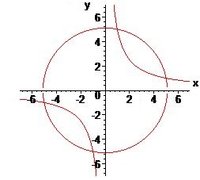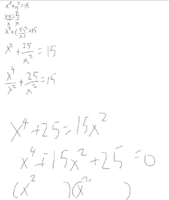… I would have expected a nicer solution in an assigned problem, but this happens in real life!
At least it wasn't an exam problem, heh.
For all readers, changing the first equation in the op to x^2+y^2=
26 yields a nicer solution. Here's a worked solution, for that example. The actual exercise may be solved the same way.
As before, y = 5/x and we're still interested only in solutions where x and y are both negative (i.e., solutions in Quadrant III).
x^2 + (5/x)^2 = 26
x^2 + 25/x^2 = 26
x^4 + 25 = 26x^2
x^4 - 26*x^2 + 25 = 0
Let u = x^2 (then u^2 = x^4), and make the substitutions.
u^2 - 26u + 25 = 0
The left-hand side factors, but I'll use the Quadratic Formula to solve for u, since that's what we'd do in the actual exercise.
u = [26 ± √
( (-26)^2 - 4(1)(25) )] / [2(1)]
The
Discriminant ( b^2 - 4ac ) evaluates to 576, which is 24^2. (This is the hallmark of quadratic polynomials that factor nicely: their Discriminant is always a perfect square.)
u = [26 ± 24] / 2
u = 13 ± 12
u = 25 or u = 1
Back-substituting these results into u = x^2, we obtain equations in terms of x.
25 = x^2
\(\;\) 1 = x^2
Solving those give solutions:
x = ±5 or
x = ±1
We know that y and x are related by y=5/x. We now use the negative x-values, to find corresponding y-values.
When x = -5:
y = 5/(-5)
y = -1
When x = -1:
y = 5/(-1)
y = -5
The solutions in Quadrant III are (-5,-1) and (-1,-5).
Here's some extra information. All solutions of the system appear as intersection points of the graphs.
x^2 + y^2 = 26 is the equation of a circle with radius √26, centered at the Origin.
y = 5/x is a Rational function; its graph is very similar to the graph of y=1/x.

When we consider all four solutions, we see symmetry reflected in the values:
(1, 5) \(\quad\) (-1, -5)
(5, 1) \(\quad\) (-5, -1)
This is due to the symmetry of the graphs' shapes. The system in the op reflects the same sort of symmetry.
?


